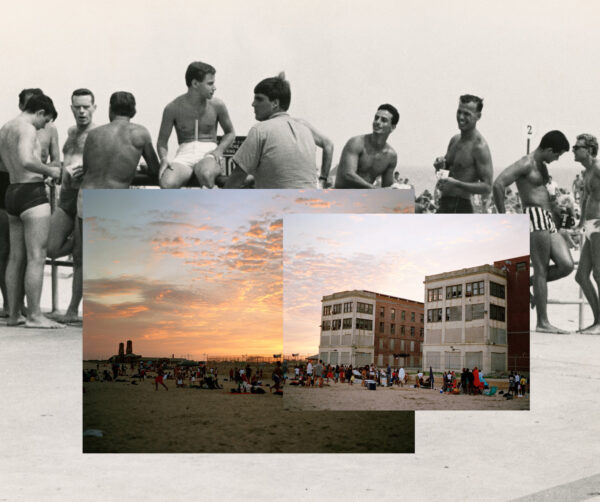There’s a particular slice of beach along the New York City shoreline, that, for the past 80 years, has been a pivotal site for queer liberation. It’s called the People’s Beach at Jacob Riis Park, also known, simply, as Riis.

This history is deeply connected to an abandoned, graffiti covered building called Neponsit Beach Hospital. For decades, this large, graffiti-covered structure loomed behind the queer sliver of Riis Beach. It formed a kind of U-shape facing the shore.
But last year, after decades of abandonment, Neponsit Hospital was demolished, and its demolition brings up critical questions about the future of the beach: how did queer Riis come to be? And what might become of it now?

In 1914, before it was a beach, Riis was a military base for the Rockaway Naval air station. Then in 1915 came the Neponsit Beach Hospital, originally intended to treat children with tuberculosis. There were beautiful porches, open-aired balconies, and eastern and western wing openings all facing the beach.
Shortly after WW1, the military abandoned its base at the beach and the city decided to create a public park there instead: Jacob Riis Park. Jacob Riis was a social reformer and photojournalist who advocated for building parks, playgrounds, and houses for the poor and working class. With bathhouses and picnic tables, the goal of Jacob Riis Park was to provide public transit accessible recreation for New York’s working class.
And then, in the 30s the whole thing was scrapped and re-designed by Robert Moses. With Moses’ redesign, the beach got an expansion, while the rest of the park, like the bathhouse, got a facelift. There was even a golf course built. Neponsit Beach Hospital stayed put, untouched and still operating.
Riis Beach in its entirety is fairly large, 260 acres to be exact. But it’s only here, in front of this hospital, that queer folks claimed as their own, as far back as the 1940s.
There was a metal fence that separated the hospital from the beach, but there was a porous relationship between beach-goers and hospital patients; some even remember passing cigarettes back and forth through the fence.

Eventually the building transitioned from a children’s hospital to nursing home. And then in 1998, a stormy weekend swept through the Rockaways, badly damaging Neponsit Beach Hospital.
This was when Rudy Giuliani was the mayor, and he made the call — in the middle of the night — to shut down the nursing home. Close to 300 nursing home residents were evacuated. Some died in the process. Renovations to the damaged building were promised to residents, but they never came. And the residents never returned.
The hospital was closed shortly after the evacuation, and it has stayed vacant ever since.

Over the next few decades, the property was stuck in a political and legal cold war. Proposals shuffled back and forth. To renovate or not, to demolish or not. In the 2000s it was estimated that millions of dollars were spent to maintain the hospital. We’re talking about things like fences, guard houses, cleaning up debris… until Spring of 2023, when the hospital was finally torn down.

Lately, arrests at Riis for public nudity and other infractions have been rising. The Rockaway Times, the local paper to that slice of Queens, published a report featuring quotes from local residents demanding an end to “Riis porn”, propping “children’s safety” as their number one concern. The organization GLITS, Gays and Lesbians Living in a Transgender Society, has been working on a proposal: a community land trust that leads to a health care facility that focuses on trans New Yorkers.
Because there aren’t many public and fairly queer spaces that especially don’t surround alcohol and expensive tickets, Riis feels to be one of the few left. But like the history of the Chelsea Piers’ queer past being erased into a playground for the rich, its legacy is at risk of being washed away.









